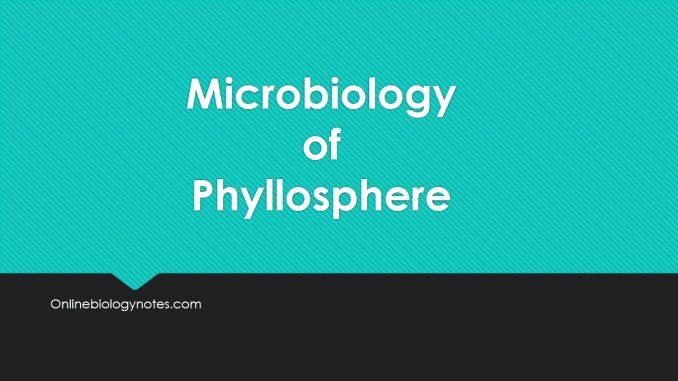
Phyllosphere:
- The surface of leaf is called phylloplane and the zone on leaf inhibited by microorganisms is called phyllosphere.
- The plant leaves are exposed to dust and air current that result in the establishment of typical flora on the surface of leaf.
- Cuticles, wax, leaf appendages and leaf exudates help in anchorage of microorganisms on the surface of leaf. These microorganisms may die, survive, multiplies on leaf depending on extent or influence of leaf exudates on microorganisms.
- Leaf exudates contains amminoacids, glucose, fructose and sucrose that provides nutrition for growth of phyllospheric microorganisms.
- Phyllospheric microorganisms also promote growth of plant by various ways.
Examples of phyllospheric microorganisms:
- The surface of leaf contains large number of bacteria, fungi, actinomycetes and algae as given below;
- Bacteria:
- Beijerinckia, Erwinia, Azotobacter, pseudomonas, Pseudobacterium, Phytomonas, Serratia etc
- Blue green algae
- Anabaena, Calothrix, Nostoc, Scytonema, Tolypothrix
- Fungi:
- Alternaria, Cladosphorium, Cercospora, Penicillium, Saccharomyces,
- Actinomycetes:
- Streptomyces
Factors that influences phyllospheric microorganisms:
- Various environmental factors and other conditions affects growth of microorganisms on the surface of leaf. They includes;
- Leaf exudates:
- Leaf exudates contains many microbial growth factors such as amino acids, glucose, fructorse, sucrose etc that facilitates growth of phyllospheric microorganisms.
- Moisture released during transpiration provides water for growth of microorganisms on leaf.
- Position of leaf:
- Position of leaf also affects phyllospheric microorganisms.
- The surface of leaf which is directly exposed to sunlight contains relatively low microorganisms than the other surface of leaf which is shaded. It is due to antimicrobial effect of UV light
- Furthermore, surface of leaf which is directly exposed to sunlight is relatively dry and moisture is less available for the microbial growth.
- Leaf appendages:
- Leaf appendages such as trough and veins affect growth of phylospheric microorganisms.
- Trough represents shallow depression on the surface of leaf. Microorganisms attach easily and grow in trough. Therefore the number of microorganisms is relatively higher on depressed area on the leaf.
- Veins present in leaf form depression in one surface and hence influence number of microorganisms.
- Stomatal cavities:
- In stomata water is in the form of drops that provides moisture for growth of phyllospheric microorganisms. Therefore number of microorganisms is relatively high in and around the stomatal cavities.
- Age and types of plants:
- With age of plant, rate of secretion of exudates is altered that affect growth of phyllospheric microorganisms, number of stomata and hence rate of transpiration is different in different plant species that affects growth of phyllospheric microorganisms.
- Environmental pollutants:
- Environmental pollutants deposited on the surface of leaf in the form of dust influence growth of phyllospheric microorganisms.
- For examples; cement and fertilizers are anti-microbial and they decrease number of phyllospheric microorganisms.
- Insecticides, Antibiotics, herbicides etc:
- Insecticides, antibiotics, herbicides and other chemical sprayed on leaf on agricultural crops are antimicrobial and decreases the number of phyllospheric microorganisms.
- Phytoalexin:
- Phytoalexins are the chemicals produced by plants leaf that inhibits phyllospheric microorganisms as well as other microorganisms.
- Nature of phytoalexin differ from plant to plant.
- Phytoalexin is produced by plant in response to certain stimuli called elicitor.
- Elicitors may be biotic or abiotic factors.
- Biotic elictors includes various chemicals produce by pathogenic and other phyllospheric microorganisms.
- Abiotic elicitor includes Uv light, cold, tissue damage etc. When phytoalexin is produced by leaf, number of phyllospheric microorganisms decreases.
Role of phyllospheric microorganisms:
- Phyllospheric microorganisms are important for plant growth. They promote growth of plants by various ways as given below;
- Some phyllospheric microorganisms such as Cyanobacteria and nitrogen fixing bacteria such as Azotobacter fix atmospheric Nitrogen and provide it to plant growth.
- Phyllospheric microorganisms produce various plant growth hormones such as indole acetic acid (IAA), which is used by plant for their growth.
- Phyllospheric microorganisms provide stimulus for production of phytoalexin by plants. Phytoalexin is the defensive chemical produced by plants that kill pathogenic as well as other microbes.
- Phyllospheric microorganisms decompose leaf and help in formation of humus after falling of leaves from plant.
- Some phyllospheric organisms have antagonistic effects against fungal pathogen and hence protect the plants from fungal diseases.
- The phyllospheric microorganisms colonize the surface of leaf forming a layer. Therefore these organisms compete with pathogenic microorganisms for habitat and nutrients.
- Some phyllospheric microorganisms degrade wax and cuticle of leaf and damage it.
Effect of plants on phyllospheric microorganisms:
- Surface of leaf provides natural habitat for growth and multiplication of phyllospheric microorganisms. Various leaf appendages as well as wax, cuticles and leaf exudates help in attachment of phyllospheric microorganisms to the surface of leaf.
- Aminoacids, glucose, sucrose etc present in leaf exudates provides nutrition for growth of phyllospheric microorganisms. Similarly water released during transpiration provides moisture for growth.
- Plants usually support growth and activities of phyllospheric microorganisms. However sometimes plant produce phytoalexins that kills many phyllospheric microorganisms.
